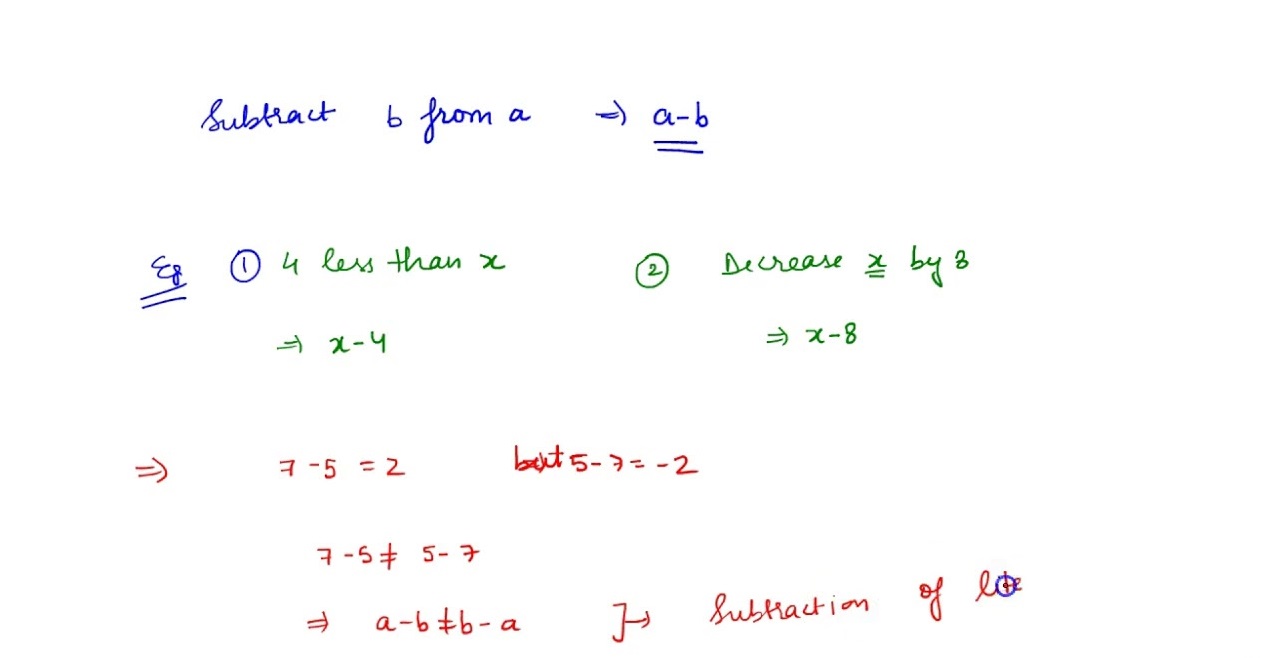Subtraction of Literals
When asked to subtract four from six, we write 6 – 4.
(Any subsequent number must be written first). When asked to subtract a number from a literal a, such as 4, we write
a – 4 is pronounced as 'a minus 4'. Four. Take note that a – 4 may alternatively be interpreted as 'four less than the actual value of a'.
Similarly, we write a – b when subtracting b from a. Additionally, we may interpret a – b as 'b less than a'.
If we subtract a from b, the result is b – a. (a – b) – c denotes the subtraction of b from a, followed by the subtraction of c from the result. Additionally, we may state that c is removed from the difference between b and a.
It should be emphasized that commutativity and associativity of subtraction do not apply to literals in the same way that they do not apply to integers.
Some essential examples of subtraction of Literals:
# 4 less than literal x
Ans: x – 4
# 10 less than literal p
Ans: p – 10
# Decrease x by 6
Ans: x – 6
# Decrease m by n
Ans: m – n
# Subtract 2 from x
Ans: x – 2
# Subtract z from 5
Ans: 5 – z
# p less than a sum of q and 7
Ans: (q + 7) – p
# 5 less than a sum of x and y
Ans: (x + y) – 5
# Decrease the sum of p and q by r
Ans: (p + q) – r
# Decrease the sum of x and 10 by y
Ans: (x + 10) – y
# 6 is diminished by z
Ans: 6 - z
# x less than 6
Ans: 6 - x
# 2 taken away from y
Ans: y - 2
# P taken away from Q
Ans: P - Q
Subtracting same literals
Let us learn how to subtract two same literal numbers.
Consider
x - x
x is a literal number and subtract it by the same literal. There are two symbols in this case. Actually, the value of "x" is unknown but their difference is zero because they both have the same
x- x = 0
Subtracting different literals
Let’s learn how to subtract two different literal numbers.
x - y
x and y are two distinct literal integers with unknown values. As a result, it is difficult to determine their distinction. Thus, the subtraction of them is easily expressed as an algebraic equation.
Do subtraction of literals follow Commutative, Associtive, and identity properties?
The answer is no. For example, let’s deal with numbers first.
4 - 3 = 1, but, 3 - 4 = -1. The answer differs. So they don’t obey commutative property. Similarly, since literals are based on numbers, they may not follow the commutative property.
On the same lines, let us consider:
(2 - 4) - 1 = -2 - 1 = -3 ...(1)
Now let us see what is the answer of: 2 - (4 - 1) = 2 - 3 = 1 … (2)
From (1) and (2), we infer that they don’t follow associative property
Similarly, 1 - 0 is not equal to 0 - 1. Hence, they don’t follow identity property.


